U.S. Department of Transportation
Federal Highway Administration
1200 New Jersey Avenue, SE
Washington, DC 20590
202-366-4000
Improvements cited in this section include removal of hazards, redesigning obstacles, relocating obstacles, reducing impact severity with breakaway devices, shielding obstacles, or delineation. These are common hazards on rural roadways. Some treatments in this section also appear in the sections on pavement and shoulder treatments.
| Safety Treatment | For more information, visit page | Cost | Frequency of Maintenance (years) | Safety Benefit | Benefit Cost Ratio34 | |||||
|---|---|---|---|---|---|---|---|---|---|---|
| Initial Implementation | Ongoing Maintenance | NCHRP 500 Performance Rating | Crash Modification Factor (CMF) | Lower Volume*, Optimal Conditions*** | Higher Volume**, Optimal Conditions*** | Lower Volume*, Narrower Conditions**** | Higher Volume**, Narrower Conditions**** | |||
| Install a Safety Edge | 114 | $ | - | 20 | P | 0.85-0.92 | 33.4 | 267.2 | 40.9 | 403.2 |
| Improve Sight Distance by Controlling Roadside Vegetation | 115 | $-$$ | T | |||||||
| Convert Culvert Headwalls to Traversable End Treatments | 116 | $-$$ | P | |||||||
| Remove Guardrail | 117 | $-$$ | U | |||||||
| Install or Maintain a Graded Shoulder | 118 | $$$ | P | 0.52 | ||||||
| Relocate Select Hazardous Utility Poles | 119 | $$$-$$$$ | P | ≤ 0.71 | ||||||
| Install Median Guardrail | 120 | $$$-$$$$ | ||||||||
| Modify End Treatments of Existing Guardrail | 121 | $$$-$$$$ | P | |||||||
| Install Impact Attenuation Devices at Select Roadside Hazard Locations (Such as Exposed Bridge Columns) | 122 | $$$-$$$$ | P | 0.31-0.54 | ||||||
| Remove or Shield Obstacles in Clear Zone | 123 | $$$$ | $$ | 5 | P | ≤ 0.71 | 3.3 | 26.7 | 4.6 | 45.2 |
| Increase Shoulder Width | 124 | $$$$-$$$$$ | P | 0.90-0.97 | ||||||
| Widen Existing Median or Construct Median | 125 | $$$$-$$$$$ | P | |||||||
| Install Median Cable Barrier | 126 | $$$-$$$$ | P | 0.71 | ||||||
| Flatten Road Sideslope | 127 | $$$$$ | - | 10 | P | 0.58 | n/a | n/a | 0.2 | 1.9 |
| Create or Increase Clear Zone | 128 | $$$$$ | - | - | P | 0.56-0.87 | 1.0 | 7.9 | 1.5 | 14.6 |
| Add Paved Shoulder | 129 | $$$$$ | $$ | 2 | P | 0.86 | n/a | n/a | 0.5 | 4.5 |
| Install Concrete Median Barrier | 130 | $$$$$ | P | |||||||
Cost: NCHRP 500 Performance rating35 *Lower Volume ≤ 1000 vpd |
||||||||||
When a vehicle leaves the traveled way and encounters a pavement-shoulder drop-off, it can be difficult for the driver to return safely to the roadway. A safety edge is a treatment intended to minimize drop-off-related crashes. With this treatment, the pavement edge is sloped at an angle (30-35 degrees) to make it easier for a driver to safely reenter the roadway after inadvertently driving onto the shoulder. This treatment is designed to be a standard policy for any overlay project.
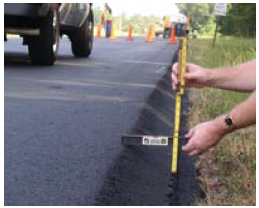
Where to Use: Each State should implement policies and procedures to incorporate the Safety Edge where pavement and non-pavement surfaces interface on all paving and resurfacing projects with surface differentials of 2.5 inches or more. The differentials should be measured from the pavement surface to the adjacent non-pavement surface, accounting for grading along the pavement edge during construction and including existing drop-offs. The Safety Edge is appropriately used at locations where pavement edge drop-offs occur through everyday use, particularly on rural roads with unpaved shoulders.
Note: In general, the Safety Edge is used the entire length of a project, rather than only in locations where a drop-off exists for a short distance.
| Install a Safety Edge - Initial Investment: $2,145 - Cost of Maintenance: n/a - Frequency of Maintenance: 20 years |
Benefit-Cost Ratio | NCHRP 500 Performance Rating | Crash Modification Factor (CMF) |
|---|---|---|---|
| Lower Volume Optimal Conditions | 33.4 | Proven | 0.85-0.92 |
| Higher Volume Optimal Conditions | 267.2 | Proven | 0.85-0.92 |
| Lower Volume Narrower Conditions | 40.9 | Proven | 0.85-0.92 |
| Higher Volume Narrower Conditions | 403.2 | Proven | 0.85-0.92 |
Top Recommended Resources:
1. FHWA, "Proven Safety Countermeasures: Longitudinal Rumble Strips and Stripes on 2-Lane Roads," April 2012. Available at: http://safety.fhwa.dot.gov/provencountermeasures/fhwa_sa_12_008.htm.
2. FHWA, "Promoting the Implementation of Proven Safety Countermeasures," memorandum. January 12, 2012. Available at: http://safety.fhwa.dot.gov/provencountermeasures/pc_memo.htm.
3. FHWA, Roadway Departure Safety: A Manual for Local Rural Road Owners, January 2011. Available at: http://safety.fhwa.dot.gov/local_rural/training/fhwasa1109/fhwasa1109.pdf
Vegetation control helps lessen the likelihood of fixed-object crashes. Proper maintenance of tall grass, weeds, brush, and tree limbs and can help improve drivers' sight distance of the road ahead, traffic control devices, approaching vehicles, wildlife and livestock, and pedestrians and bicycles.
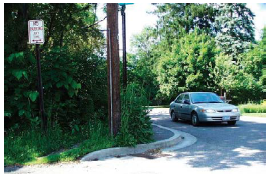
Where to Use: This treatment is appropriate to use at all locations, especially those in rural areas where vegetation growth is high.
| Safety Treatment | Initial Implementation Cost | NCHRP 500 Performance Rating |
|---|---|---|
| Improve Sight Distance by Controlling Roadside Vegetation | $0 to $20,000 | Tried |
Top Recommended Resource:
1. FHWA, Vegetation Control For Safety: A Guide for Local Highway and Street Maintenance Personnel, August 2008. Available at: http://safety.fhwa.dot.gov/local_rural/training/fhwasa07018/vegetationfv1108.pdf.
Culvert headwalls may act as a fixed object once vehicles leave the roadway. By installing traversable culvert end treatments, vehicles may be able to drive over them without rolling over or experiencing an abrupt change in speed.
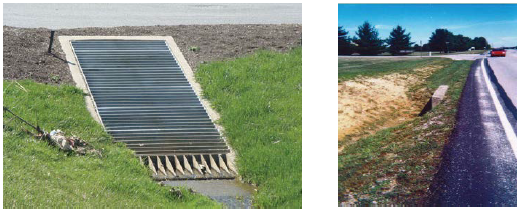
Where to Use: This treatment is applicable for locations where culvert headwalls are perpendicular to and lie in close proximity to the traveled way.
| Safety Treatment | Initial Implementation Cost | NCHRP 500 Performance Rating |
|---|---|---|
| Convert Culvert Headwalls to Traversable End Treatments | $0 to $20,000 | Proven |
Top Recommended Resource:
1. FHWA, Maintenance of Drainage Features for Safety: A Guide for Local Street and Highway Maintenance Personnel, July 2009. Available at: http://safety.fhwa.dot.gov/local_rural/training/fhwasa09024/fhwasa09024.pdf.Removal of guardrail that no longer provides a safety benefit can help eliminate a roadside obstacle. Each removal should be evaluated on a case-by-case basis.
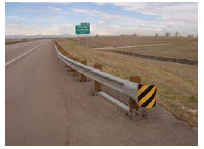
Where to Use: This treatment may be used at locations where guardrails no longer provide a safety benefit (e.g., locations where sideslopes have been improved behind the guardrail or where roadside obstacles have been removed).
| Safety Treatment | Initial Implementation Cost | NCHRP 500 Performance Rating |
|---|---|---|
| Remove Guardrail | $0 to $20,000 | Unkown |
Installing a stabilized earth or graded shoulder adjacent to the travel lane provides a recovery area for vehicles if they should depart the road. The shoulder provides as an opportunity for drivers to correct their direction of travel by re-entering the roadway. It may also serve as a buffer before traversing the sideslope.
Where to Use: This treatment may be used at locations where no shoulders exist and/or where roadway departure crashes frequently occur.
| Safety Treatment | Initial Implementation Cost | NCHRP 500 Performance Rating | Crash Modification Factor (CMF) |
|---|---|---|---|
| Install or Maintain a Graded Shoulder | $20,001 to $50,000 | Proven | 0.52 |
Relocating or removing utility poles from within the clear zone alleviates the potential for fixed-object crashes. If utility poles cannot be completely eliminated from within the clear zone, efforts can be made to either relocate the poles to a greater offset from the road or delineated.
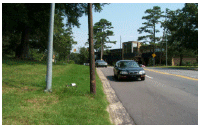
Where to Use: This treatment may be used at locations where utility pole fixed-object crashes occur or are more likely to occur due to the proximity of the poles to the roadway, such as along the outside of horizontal curves.
| Safety Treatment | Initial Implementation Cost | NCHRP 500 Performance Rating | Crash Modification Factor (CMF) |
|---|---|---|---|
| Relocate Select Hazardous Utility Poles | $20,001 to $50,000 | Proven | ≤ 0.71 |
Top Recommended Resource:
1. Transportation Research Board. NCHRP Report 500 / Guidance for Implementation of the AASHTO Strategic Highway Safety Plan, Volume 8: A Guide for Reducing Collisions Involving Utility Poles, June 2004. Available at: http://onlinepubs.trb.org/Onlinepubs/nchrp/nchrp_rpt_500v8.pdf.
The installation of median guardrail is most suitable for use in traversable medians having no or little change in grade and cross slope. While these systems may not reduce the frequency of crashes due to roadway departure, they can help prevent a lane-departure crash from becoming a head-on collision.
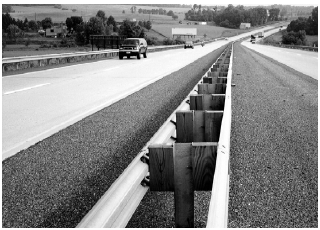
Where to Use: This treatment may be used on divided highways with 20,000 ADT or greater that have a system-wide history of cross-median crashes. Highways with medians less than 50 feet wide. The treatment should be applied systemically using logical end points, not at specific locations.
| Safety Treatment | Initial Implementation Cost |
|---|---|
| Install Median Guardrail | $20,001 to $100,000 |
Top Recommended Resource:
1. FHWA, Median Barriers, September 2010. Available at: http://safety.fhwa.dot.gov/roadway_dept/policy_guide/road_hardware/ctrmeasures/median_barriers/.
The installation of a crashworthy end treatment can be used to prevent impact with guardrail ends by safely decelerating the vehicle or by safety redirecting it around the object of concern.
Where to Use: This treatment may be used at guardrail locations that have experienced severe crashes or have not performed as desired when hit. Also, any currently-installed "turn-down" or blunt guardrail ends.
| Safety Treatment | Initial Implementation Cost | NCHRP 500 Performance Rating |
|---|---|---|
| Modify End Treatments of Existing Guardrail | $20,001 to $100,000 | Proven |
An impact attenuator, also known as a crash cushion or crash attenuator, is a device intended to reduce the damage to vehicles, motorists, and structures as a result of a motor vehicle collision. Attenuators may be installed to protect bridge columns and other narrow roadside obstacles.
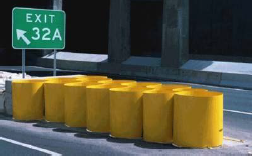
Where to Use: This treatment may be used at locations where roadside hazards are relatively close to the road, or where fixed object crashes have occurred.
| Safety Treatment | Initial Implementation Cost | NCHRP 500 Performance Rating | Crash Modification Factor (CMF) |
|---|---|---|---|
| Install Impact Attenuation Devices at Select Roadside Hazard Locations (Such as Exposed Bridge Columns) | $20,001 to $100,000 | Proven | 0.31-0.54 |
Removing, redesigning, marking, or relocating fixed objects within the clear zone reduces the likelihood of a crash. If a crash occurs, adding breakaway features, crash cushions, or redirection devices reduces crash severity.

Where to Use: Depending on the type and location of the obstacle, several methods to improve the clear zone exist.
These include:
| Remove or Shield Obstacles in Clear Zone - Initial Investment: $70,000 - Cost of Maintenance: $7,000 - Frequency of Maintenance: 5 years |
Benefit-Cost Ratio | NCHRP 500 Performance Rating | Crash Modification Factor (CMF) |
|---|---|---|---|
| Lower Volume Optimal Conditions | 3.3 | Proven | ≤ 0.71 |
| Higher Volume Optimal Conditions | 26.7 | Proven | ≤ 0.71 |
| Lower Volume Narrower Conditions | 4.6 | Proven | ≤ 0.71 |
| Higher Volume Narrower Conditions | 45.2 | Proven | ≤ 0.71 |
Top Recommended Resources:
1. FHWA, Toolbox of Countermeasures and Their Potential Effectiveness for Roadway Departure Crashes, August 2008. Available at: http://safety.fhwa.dot.gov/tools/crf/resources/briefs/rdwydepartissue.cfm.
2. FHWA, Roadway Departure Safety: A Manual for Local Rural Road Owners, January 2011. Available at: http://safety.fhwa.dot.gov/local_rural/training/fhwasa1109/fhwasa1109.pdf.
Increasing shoulder width may offer the following benefits:
The benefits seen by increasing shoulder width vary based on before and after conditions, road classification, speed, and the presence of multiple road user types. Increasing shoulder width within horizontal curve sections may help agencies maximize use of the treatment while minimizing costs, as opposed to adding widening shoulders to an entire corridor.
Where to Use: For narrow pavement widths, it is beneficial to provide narrower lanes with wider shoulders at low AADTs (less than 1,000 vpd), while the configuration with 12-foot lanes and no shoulders appears to be most beneficial for large AADTs (greater than 1,000 vpd).
| Safety Treatment | Initial Implementation Cost | NCHRP 500 Performance Rating | Crash Modification Factor (CMF) |
|---|---|---|---|
| Install Impact Attenuation Devices at Select Roadside Hazard Locations (Such as Exposed Bridge Columns) | $50,001 to $100,000 | Proven | 0.90-0.97 |
Top Recommended Resource:
1. FHWA, Safety Evaluation of Lane and Shoulder Width Combinations on Rural, Two-Lane, Undivided Roads, June 2009. Available at: https://www.fhwa.dot.gov/publications/research/safety/09031/09031.pdf.
Use of these treatments helps to provide additional lateral distance between opposing traffic.

Where to Use: This treatment may be applicable when high frequencies of head-on collisions exist.
| Safety Treatment | Initial Implementation Cost | NCHRP 500 Performance Rating |
|---|---|---|
| Widen Existing Median or Construct Median | $50,001 to $100,000 | Proven |
Median cable barrier systems are considered the most versatile and forgiving barrier systems available for reducing the severity of median crossover crashes. While these systems may not reduce the frequency of crashes due to roadway departure, they can help prevent a lane-departure crash from becoming a head-on collision.
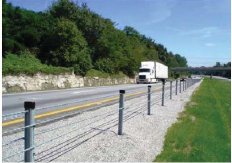
Where to Use: This treatment may be used on divided highways that have a system-wide history of cross-median crashes and highways with medians less than 50 feet wide. The treatment should be applied systemically using logical end points, not at specific locations.
| Safety Treatment | Initial Implementation Cost | NCHRP 500 Performance Rating | Crash Modification Factor (CMF) |
|---|---|---|---|
| Install Median Cable Barrier | $120,000 | Proven | 0.71 |
Top Recommended Resource:
1. FHWA, Median Barriers. Available at: http://safety.fhwa.dot.gov/roadway_dept/policy_guide/road_hardware/ctrmeasures/median_barriers/
By reducing the amount of road sideslope, vehicles are better able to recover after leaving the travelway. The flatter the slope, the more traversable the sideslope becomes.
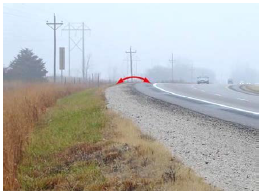
Where to Use: This treatment may be used at locations that have experienced overturn crashes, on the outside of curves with small radii, where the sideslope has a slope of greater than 3:1.
| Flatten Road Sideslope - Initial Investment: $1,000,000 - Cost of Maintenance: n/a - Frequency of Maintenance: 10 years |
Benefit-Cost Ratio | NCHRP 500 Performance Rating | Crash Modification Factor (CMF) |
|---|---|---|---|
| Lower Volume Optimal Conditions | n/a | Proven | 0.58 |
| Higher Volume Optimal Conditions | n/a | Proven | 0.58 |
| Lower Volume Narrower Conditions | 0.2 | Proven | 0.58 |
| Higher Volume Narrower Conditions | 1.9 | Proven | 0.58 |
Top Recommended Resources:
1. FHWA, Toolbox of Countermeasures and Their Potential Effectiveness for Roadway Departure Crashes, August 2008. Available at: http://safety.fhwa.dot.gov/tools/crf/resources/briefs/rdwydepartissue.cfm.
2. FHWA, Roadway Departure Safety: A Manual for Local Rural Road Owners, January 2011. Available at: http://safety.fhwa.dot.gov/local_rural/training/fhwasa1109/fhwasa1109.pdf.
A clear zone is an unobstructed, traversable roadside area that allows a driver to stop safely or regain control of a vehicle that has left the roadway. The width of the clear zone should be based on risk (also called exposure). Key factors in assessing risk include traffic volumes, speeds, and slopes, in accordance to the AASHTO Roadside Design guide. Clear roadsides consider both fixed objects and terrain that may cause vehicles to rollover. Creating or increasing clear zones within horizontal curve sections may help agencies maximize use of the treatment while minimizing costs, as opposed to providing a clear zone throughout an entire corridor.
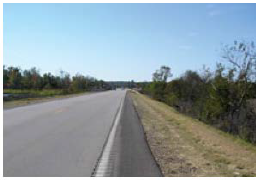
Where to Use: A clear zone should be developed on every roadway where space is available. In situations where public right-of-way is limited, steps should be taken to request assistance from property owners or seek volunteer easements, as appropriate.
| Create or Increase Clear Zone - Initial Investment: $300,000 - Cost of Maintenance: n/a - Frequency of Maintenance: n/a |
Benefit-Cost Ratio | NCHRP 500 Performance Rating | Crash Modification Factor (CMF) |
|---|---|---|---|
| Lower Volume Optimal Conditions | 1.0 | Proven | 0.56-0.87 |
| Higher Volume Optimal Conditions | 7.9 | Proven | 0.56-0.87 |
| Lower Volume Narrower Conditions | 1.5 | Proven | 0.56-0.87 |
| Higher Volume Narrower Conditions | 14.6 | Proven | 0.56-0.87 |
Top Recommended Resources:
1. FHWA, Clear Zones, Available at: http://safety.fhwa.dot.gov/roadway_dept/clear_zones/
2. FHWA, Roadway Departure Safety: A Manual for Local Rural Road Owners, January 2011. Available at: http://safety.fhwa.dot.gov/local_rural/training/fhwasa1109/fhwasa1109.pdf.
3. AASHTO, Roadside Design Guide, September 2011.
The addition of a paved shoulder to an existing road can help to reduce run-off-road crashes. Benefits can be realized for any HRRR without paved shoulders regardless of existing lane pavement width. Adding a paved shoulder within horizontal curve sections may help agencies maximize use of the treatment while minimizing costs as opposed to adding paved shoulders to an entire corridor.
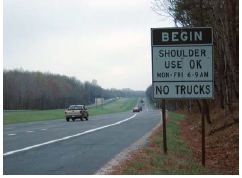
Where to Use: This treatment may be used on any HRRR without a paved shoulder.
| Add Paved Shoulder - Initial Investment: $400,000 - Cost of Maintenance: $20,000 - Frequency of Maintenance: 2 years |
Benefit-Cost Ratio | NCHRP 500 Performance Rating | Crash Modification Factor (CMF) |
|---|---|---|---|
| Lower Volume Optimal Conditions | n/a | Proven | 0.86 |
| Higher Volume Optimal Conditions | n/a | Proven | 0.86 |
| Lower Volume Narrower Conditions | 0.5 | Proven | 0.86 |
| Higher Volume Narrower Conditions | 4.5 | Proven | 0.86 |
Concrete median barriers are longitudinal barriers used to separate opposing directions of traffic. While these systems may not reduce the frequency of crashes due to roadway departure, they can help prevent a lane-departure crash from becoming a head-on collision.

Where to Use: Concrete median barriers can be used in urban or rural locations that experience frequent head-on collisions when:
| Safety Treatment | Initial Implementation Cost | NCHRP 500 Performance Rating |
|---|---|---|
| Install Concrete Median Barriers | $100,001 and up | Proven |
34 As discussed in Section 1.2, a BCR is only shown where data were available to calculate the ratio. Where data were unavailable, the BCR has been left blank. [ Return to note 34. ]
35 As stated in NCHRP Series 500 Reports (http://safety.transportation.org/guides.aspx). Proven: The safety effect for other similar applications has shown a proven benefit. Tried: The treatment has indications that it can be expected to reduce crashes, but has some conflicting reports as to its associated safety effects or has been deployed and observed to be effective. Experimental: New treatments that still need to be tested and for which the safety effect is unknown. Unknown: Not enough is known about an associated safety performance. [ Return to note 35. ]
